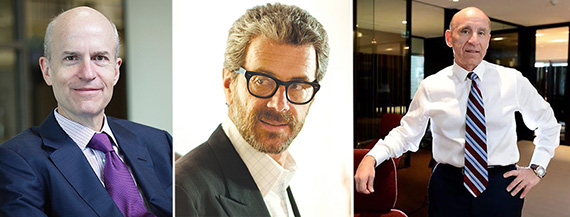Trending
Rufrano tries to steady American Realty Capital ship, and more highlights from REIT Week
New York REIT, Empire State, Boston Properties among Wednesday speakers at forum

Empire State’s Malkin high on ESB observatory — but not on WeWork
Empire State Realty Trust chair and CEO Tony Malkin started his presentation at REIT Week by touching on familiar territory, citing the company’s “four drivers” for low-risk, embedded growth within its Manhattan portfolio.

The Empire State Building
But he also had some interesting things to say about the company’s flagship asset — the Empire State Building — and how its lucrative observation deck compares to 1 World Trade Center’s recently opened observatory in the Financial District.
“We like our competitive position,” Malkin said, noting the terms of vendor Legends Hospitality’s fixed-rent obligation at 1 World Trade Center and describing the Empire State Building’s model as “far better and more profitable.”
“We really believe that there’s a Midtown day and a Downtown day,” he added, pointing to the observation deck’s longer hours and how the building’s “international brand” had seen off past challenges from the likes of Rockefeller Center’s Top of the Rock.
Malkin was more skeptical about the much-hyped trend of TAMI tenants in the Manhattan office market, however — noting that the company “won’t lease to WeWork” and is consciously “insulating” itself from tenants catering to a “part-time” workforce.
“When these companies grow up, they’ll want a real building and a real landlord,” he said of the unorthodox, industrial-style work spaces desired by such tenants. “They’ll need to get to meetings.”[vision_pullquote style=”1″ align=””] “When these companies grow up, they’ll want a real building and a real landlord.” – Tony Malkin [/vision_pullquote]
Elsewhere, Malkin talked up the REIT’s holdings in the Garment District and how the “pedestrian promenade that’s developed” between Times Square and Herald Square has boosted retail in the area and “changed the whole environment” for Properties Like 1400 Broadway.
And regarding whether a move was possible for the Helmsley Building at 230 Park Avenue — which RXR Realty acquired for $1.2 billion last month — Malkin stressed that ESRT is “not going to do competitive bidding in this market,” describing it as a “waste of money and time.”
ESRT expects to see an additional $32 million in annual rent from signed leases commencing over the next 18 months, he added.
Rufrano tries to steady American Realty Capital ship
It’s been a tumultuous 12 months for American Realty Capital Properties, to say the least. On Wednesday, new CEO Glenn Rufrano took the podium at the New York Hilton in Midtown by himself, with no accompanying executives or industry analysts in sight.
Rufrano, who started on the job April 1, rehashed how an “accounting irregularity” had thrown the company into a tailspin from which it is just now steadying. While admitting that there was “not much of a foundation to the company” when he took over, he expressed the REIT’s desire to regain credibility through establishing a new corporate governance structure and implementing a new business plan.
[vision_pullquote style=”1″ align=”right”] “Once the market understands our corporate governance and business plan, we can start to get healthy.” – Glenn Rufrano [/vision_pullquote]Once the corporate governance aspect is settled, American Realty Capital is “going to review our assets and all those acquisitions” made over the past several years and consider factors ranging from geography to tenant concentration in defining the company’s core and non-core assets, Rufrano said. By the end of the review, “we hope and expect a fully-diversified portfolio that is risk-adjusted,” he added.
Beyond that, the former Cushman & Wakefield CEO said the REIT would “like to get back to investment grade” after losing that distinction in wake of the accounting scandal. “Once the market understands our corporate governance and business plan, we can start to get healthy,” Rufrano said. “We believe we can get there in a reasonable period of time.
While ruling out a “fire sale,” he did add that American Realty Capital would be a “a net seller” this year and would not see any acquisitions “unless we committed to buy something prior to me coming on.” Rufrano also backed the company’s existing, “well-diversified” asset portfolio that gives it a presence in 49 states.
But there’s no doubt that the REIT is still feeling the effects of what came before. “We have a lot of lawyers running around this company right now,” Rufrano said in response to a question, citing $10 million in legal fees for American Realty Capital in the first quarter.
Happel trying to keep distance from Schorsch era
New York REIT CEO Michael Happel, meanwhile, attempted to distance his company from the Nicholas Schorsch era. The American Realty Capital spinoff reached out to Barclays to explore a possible sale last year, and Happel noted how many in the market “thought maybe this was a distressed sale” due to the difficulties at ARC.
“It does feel like an accounting problem at a different company has wreaked havoc on my company,” Happel said.
In the end, there was no sale of New York REIT, with the company ending the strategic process exploring the possibility on May 11. “We felt none of the proposals received reflected fair value,” Happel noted, adding that if such a fair value offer were to come in on any given day, the company would be “absolutely open to that.”
[vision_pullquote style=”1″ align=””] “It does feel like an accounting problem at a different company has wreaked havoc on my company.” – Michael Happel [/vision_pullquote]Happel expressed his belief that the city’s office market “is moving even more in the landlord’s favor” after office rents jumped 8 percent year-on-year in the fourth quarter of 2014, citing “extremely good” capital flows from real estate investors and particularly those from abroad. “Office values are pretty much back at the same level they were in [2007],” he said, admitting a “glass half-full” perspective in predicting the market as in the “early stages” of a rent spike.
Happel also talked up the REIT’s primary asset at One Worldwide Plaza, describing how the property’s location, on West 50th Street between Eighth and Ninth avenues, “continues to get better and better every day.”
New York REIT owns a 49 percent stake in the building, though the company also has a fixed-price purchase option in 2017 — a valuable asset that “doesn’t show up on our balance sheet,” he noted. Happel acknowledged speculation regarding whether the company would have the capital to exercise that option, citing an “existing mortgage on the property that would be assumed” and expressing confidence that the REIT could raise the $220 million needed to seal the deal.
In addition, the company recently announced that it has placed a group of five “non-core” assets in Brooklyn and Queens on the market and is targeting proceeds between $100 million and $130 million from the sale. New York REIT is also looking at potential joint ventures “on one or two of our core assets,” Happel said.
Boston Properties looking long
One of the nation’s largest office REITs continues to bank on a conservative strategy prioritizing long-term growth over short-term returns. Boston Properties CEO Owen Thomas described the company as a “significant” seller of assets over the past few years, though proceeds from those deals have largely been targeted at developing new assets for the company.
“Given the high level of enthusiasm” for assets in the company’s core markets, Thomas noted, the company realized that it could “develop office buildings at a lower cost and higher yield” than acquiring such office properties. That has led to a strategy that sees the REIT pursuing development projects like the 1,070-foot-tall Salesforce Tower in San Francisco.
“When we sell an asset, we are reducing our FFO,” president Doug Linde, also in attendance at Boston Properties’ presentation, said. “We’re doing it with a perspective that it will help us grow long-term,” he added — acknowledging the company’s tactics as a “very different type of way of running the business.”




